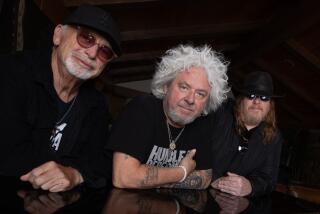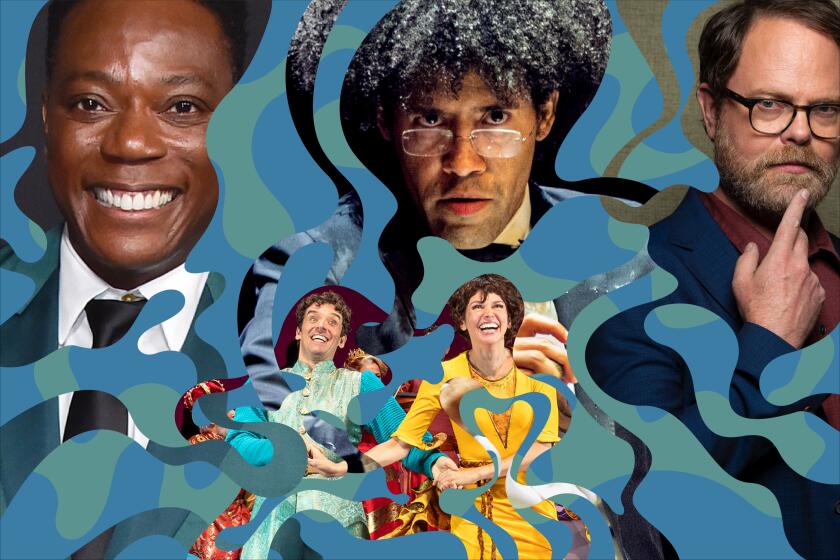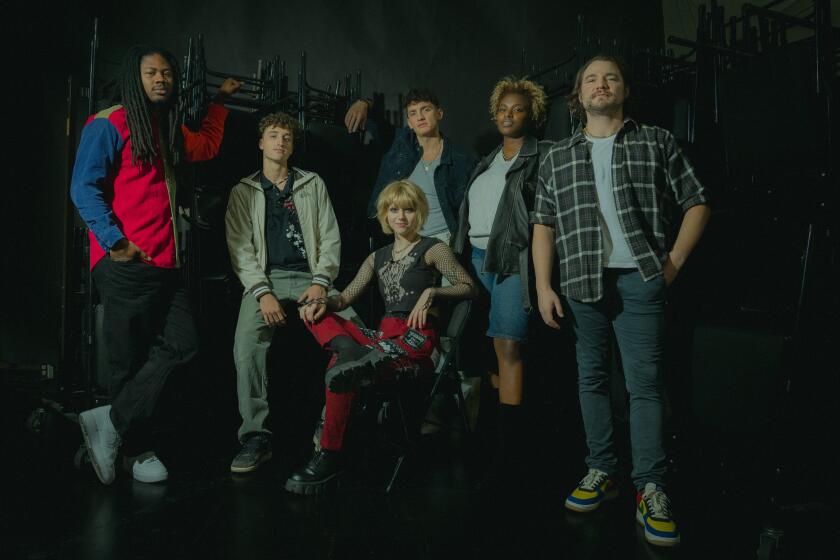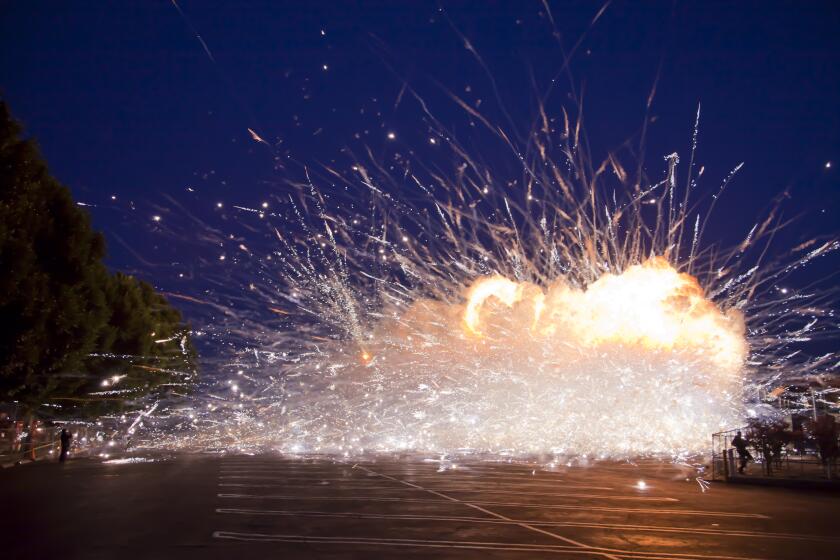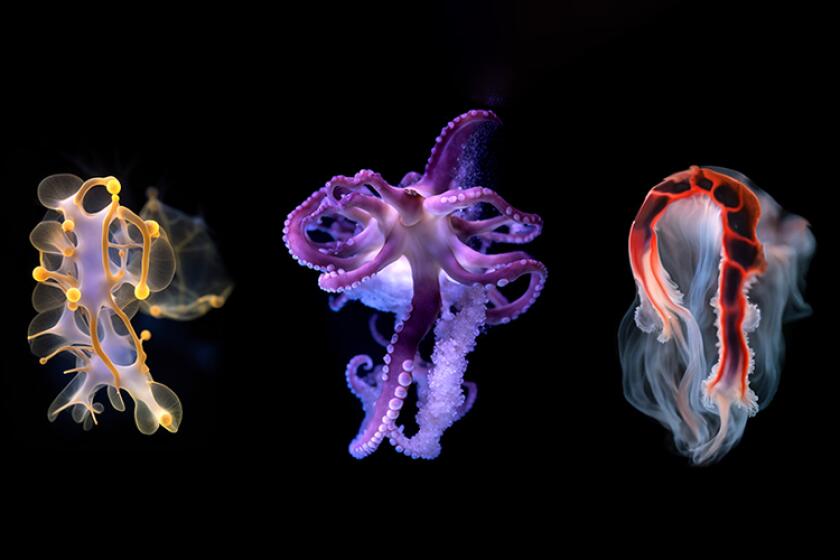ART : PATCHWORK PUZZLES : What Do ‘Sentences’ of Velvet Elvises and Fruit Say About Modern Life?
Who buys those pathetic homemade paintings and “originals” on velvet that are jumbled together with the fragmentary dish sets and broken toasters at thrift shops? Well, San Francisco artist Tony Labat is one eager consumer. He doesn’t just hang his treasures in the living room, though--he stitches them together to make his own kind of art.
Some of the results, which Labat calls the “Frankenstein Series,” are on view through March 17 at the Laguna Art Museum.
Labat, who is better known for his video work (his mixed-media video piece “Icarus: One in Hand” was chosen by Newport Harbor Art Museum for its Second Newport Biennial in 1986), has had solo exhibits in such top-notch venues as the Museum of Contemporary Art in Los Angeles, the Institute of Contemporary Art in Boston and the Museum of Modern Art in New York.
Still, some viewers might wonder how the artist can claim credit for the untitled works in this show, since all of the paintings he uses were made by other people. That’s where the postmodern idea of art as a selection from among existing styles and themes comes in.
Such subjects as landscapes, seascapes, flowers, nudes, children and animals are especially popular in amateur and trashy commercial paintings. Many people believe that a work of art is, by definition, a picture of a standard, recognizable subject. For other observers, the homemade and popular art product is more significant as a barometer of cultural values.
Labat takes that approach a step further by using the thrift store paintings as a kind of basic vocabulary. His art-making consists of creating “sentences” by stringing together different images to point up different aspects of late-20th-Century life.
For example, in one work he puts together paintings of: a cartoon-like child with big eyes and chipmunk cheeks; a sad-faced man in fur-trimmed clothing standing in a desolate snowy landscape (in Russia?); and two women in what appear to be bits and pieces of Indian garb who are surrounded by trays and baskets of fruit and flowers. An overriding sense of loss and alienation suffuses these three works, regardless of the disparity among their styles and cultural roots.
Another piece consists of two sets of “found” paintings. On the top row, the image of a stylized elongated cat preening behind a skinny tall vase contrasts with the image of a huge armless nude. In the paintings below, a bowl of fruit looks oddly like a duck’s head (artniks will recall that 16th-Century artist Archimboldo painted figures whose bodies were built up from pieces of fruit) next to a duck in a pose borrowed from the “Uncle Sam Wants You” poster.
This piece seems to be about the enormous relativity of values and appearances. One culture’s--or person’s--notion of ideal beauty may not jibe with another’s. A bowl of fruit may be a duck. A commercial art factory that produces paintings on velvet may find it profitable to revamp a famous patriotic image as anti-war art.
Other pieces in the show deal with such topics as the cult of Elvis Presley, conceptions of the sacred and profane, and the curious changes that occur when a Sunday painter decides to copy a famous work of art.
The wall text in the show says that the museum is offering Labat’s works in the spirit of curiosity and discovery--much as artists point out work they like to each other--rather than being “bound by the worn curatorial tendency of approbation and canonization.”
Actually, of course, everything a museum displays reflects its staff’s view of art that is worthwhile and likely to be important in the future. Even if it wanted to, a museum can’t decide to stop acting like a taste-making institution and start behaving like your best buddy.
Still, for viewers put off by the ineptitude of the amateur artists and confused by the seemingly unrelated imagery, it’s helpful to understand that you are supposed to do your own thinking--that you need to approach each patchwork painting as a puzzle and a meditation on the strangeness of life today.
What
“Tony Labat: New Paintings.”
When
11 a.m. to 5 p.m. Tuesday through Sunday, through March 17.
Where
Laguna Art Museum, 307 Cliff Drive, Laguna Beach.
Whereabouts
The museum is at the corner of Cliff Drive and North Coast Highway, one block from the junction of Coast Highway with Broadway.
Wherewithal
Admission is $2 for adults, $1 for seniors and students, free for children under 12.
Where to call
(714) 494-6531.
More to Read
The biggest entertainment stories
Get our big stories about Hollywood, film, television, music, arts, culture and more right in your inbox as soon as they publish.
You may occasionally receive promotional content from the Los Angeles Times.
